A World Heritage Site with Historic Monuments, Museums, and Stunning View
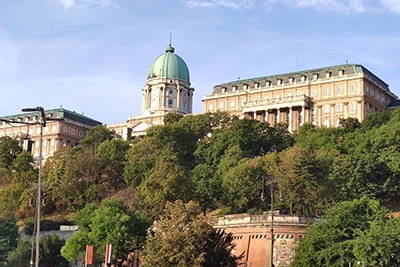
Budapest’s Castle District is packed with
- historic sights and attractions (the Royal Palace, the Matthias Church, medieval houses),
- interesting museums,
- charming, crooked streets following the shape of the hill, as well as
- some good cafés and restaurants
Besides the monuments, you get a breathtaking panorama of the Danube with the Chain Bridge and the Pest side of the city on the opposite side of the river.
Everything at one place!
It’s ideal to spend a romantic morning here in spring or on a sunny autumn day, before the tourists overrun the hill.
Table of Contents
Buda Castle and its many courtyards host several festivals and events all over the year including an international wine festival, a beer festival, and a folk art festival.
Admission to the Castle itself is free, (festivals can usually be visited with a day ticket), you’ll have to pay entry fee to the museums and the Hungarian National Gallery (History Museum, Military History Museum, Pharmacy Museum)
If you can, time your visit to one of these events to make your experience of Budapest’s castle even more satisfying.
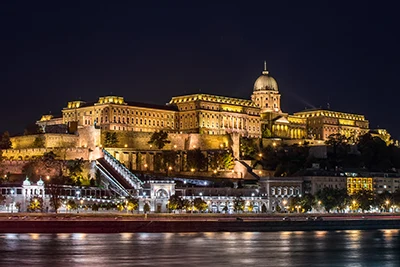
Major Sights in Buda Castle:
- Royal Palace (Királyi Palota),
- Fishermen’s Bastion (Halászbástya),
- Matthias Church (Mátyás templom)
- Faust Wine Cellar
- Labyrinth
Getting to Buda Castle
Funicular from Clark Adam Square, Buda
The best and most scenic way to get up to the hill is to take the funicular (Sikló) from Clark Ádám tér at the Buda end of the Chain Bridge.
The track is almost 100 m long.
Operating hours: 07.30 – 22.00 every day.
The cable car runs constantly during peak time, and at max 10-minute intervals during less busy periods
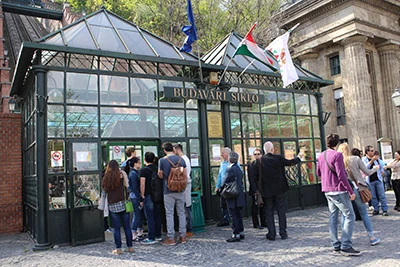
Funicular Tickets:
- Upwards: 1 200 HUF/adult, 700 for children (between 3-14 years of age)
- Return ticket 1 800 HUF, for kids between 3-14 years of age: 1 200 HUF
- Children under 3 and people with disabilities can travel on the cable car free of charge.
Bus No . 16 or 16A – Castle Bus/Várbusz
Other option is to take the Várbusz/Castle Bus No. 16 travelling between Deák Ferenc tér in Pest’s centre (M1, M2, M3 metro lines, trams 47 & 49) and Széll Kálmán tér in Buda (M2, red metro line, or tram 6). ,
It runs every 5-6 minutes during the day.
Other stops of the Castle Bus in the city centre:
- Hild tér – (between József Attila utca and Mérleg utca near the Basilica)
- Széchenyi tér (near the Four Seaons Hotel Gresham Palace),
You can also take Bus No. 16A from Széll Kálmán tér, its termini is at Díszt tér at the Royal Palace. Other stops:
- Bécsi kapu tér,
- Kapisztrán tér,
- Szentháromság tér/Holy Trinity Sqr.
A more romantic way of getting to the Castle is by taking the steps leading up the hill from Clark Adam Square.
Book a Buda Castle Cave Walking Tour

Discover the fascinating history and hidden beauty of Buda Castle with our cave tour. Explore the winding tunnels and mysterious caverns beneath the castle while learning about the castle’s past. Book now for a unique and unforgettable experience in Budapest.
Wine Tasting in Buda Castle – Faust Wine Cellar
Address: Hess András tér 1-3, district I., (within the Hilton Hotel)
Entrance: turn left in the Hall of the Hilton Hotel, walk till the Dominican Monastery Cloister, 54 steps lead down the cellar
End your sightseeing in the Castle with wine tasting in a romantic stone cellar within the Hilton.
The vaulted cellar is a part of the underground labyrinth system built by the castle inhabitants during the middle ages.
English-speaking wine experts will introduce you to the wines and wine regions of Hungary.
Find out more about the Faust Wine Cellar in Buda Castle!
A Bit of Buda Castle History
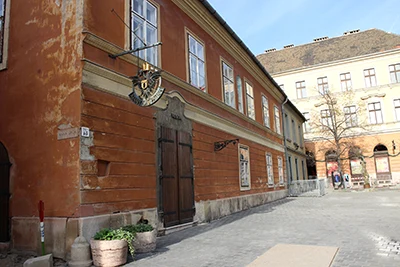
The first inhabitants moved up here in the 13th century after the devastating Mongol attacks. The Castle District’s Golden Age started when the Royal Court moved here.
During the 15th century, under the rule of King Matthias, Buda became one of Europe’s most influential cities.
The Turks invaded the Castle Hill in 1541 and ruled it until 1686 when the Austrian Habsburgs and their allied armies took back the hill. The siege left Castle District in ruins.
After the Turks the Habsburgs moved here. Reconstructions began immediately, following the old street layout.
The Castle became a government district. The current elegant Baroque appearance was formed by the mid 18th century.
The battles in 1944-45 ruined the place again.
Reconstructions after the war rebuilt the District:
- the buildings by the Habsburgs were reconstructed,
- the street pattern of the medieval city has been kept and much of the architectural features have been restored.
People still live here. Cars are banned from the area: only people who live or work there, guests of the Hilton Hotel, taxis and the Várbusz have permission to drive up.
TIP: See also our map-based Buda Castle walking tour suggestions – easy to use itinerary with lots of photos.
Guided Tour to the Hospital in the Rock & Castle

Participate in a guided walking expedition through the Buda Castle District led by a skilled tour professional. Enhance your experience by taking an additional guided tour within the caves, delving into the historical significance of the expansive subterranean bunkers from the era of World War II.
Bécsi kapu tér (Vienna Gate Square) and its Surroundings
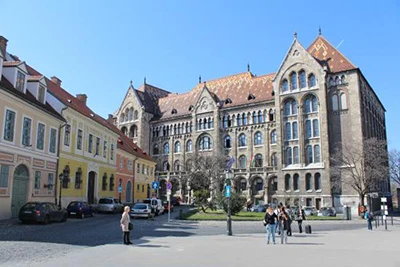
The only existing old town-gate. A very good spot to start your walk in Buda Castle. This is the northern gate of the District; all four roads that run along the hill converge here.
From here it takes only a few minutes to get to busy Széll Kálmán tér.
Bécsi kapu tér served as a Saturday Market in the middle ages for non-Jewish merchants.
You can walk up to the top of the gate where you get a beautiful view of the Buda Hills. You can see the imposing Budapest Parliament from an unusual angle.
You’ll find some charming houses around Vienna Gate too (No.-s 5 – 7).
The most famous is the house at No. 7. It was built on the site of a medieval house.
A priest and teacher, who lived here, rebuilt it in 1807. Beautiful grilles decorate the windows and the door of a staircase in the gateway.
In the first half of the 20th century Baron Lajos Hatvany lived here, a patron of arts. In 1935 and 1936 Thomas Mann was his guest in this house for three times.
The large building of the National Archives towers the northern end of the square.
Europe Grove – Európa Liget

The so-called Europe Grove is to the right of the Gate. Mayors of all the major European cities planted rare trees here in 1972.
You’ll find about 16 types of trees here, for example Turkish hazel and Japanese cherry.
Kapisztrán Square: Mary Magdalene Tower, Military History Museum
Mary Magdalene Tower
On the corner of Kapisztrán tér and Országház utca, you bump into the Mary Magdalene Tower (Mária Magdolna Torony). It was a Franciscan church in medieval times.
Under the Turkish rule this was the only Christian church; the Turks converted all the other churches into mosques.
Since this was the only Christian church, both Catholics and Protestants used it. In the end, the Turks converted it into a mosque as well.
The church was destroyed in World War II, only its 15th century tower survived the bombings. The tower has been partly restored and opened as a museum to the public in May 2015.
Panoramic View & Museum
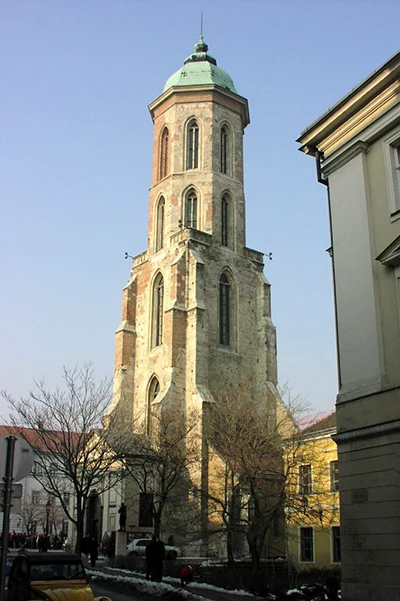
You can enjoy one of the best panoramic views from its top as well the greatest chime play of the country operating with 24 bells.
On the ground floor a photo exhibit depicts the devastation of World War II and the 1956 revolution and the overall history of the church.
Tickets to Mary Magdalene Tower: full price: 800 HUF, students (ages: 6-26), retirees (ages. 62-70): 400 HUF, families (2 adults + 1-4 kids): 1 600 HUF.
Opening hours: Tuesday-Sunday: 10.00-18.00
Military History Museum
Behind the Maria Magdalen Tower is the Military History Museum (Kapisztrán tér 2-4., Opening hours: Tue-Sun: 10.00-18.00).
Visit the room devoted to the 1956 Uprising and you’ll find out everything important about these 13 chaotic days. The hand of the legendary Stalin Statue is here too.
People destroyed the statue in the huge parking area behind Műcsarnok in Heroes’ Square during the uprising.
A remarkable historical weapon collection, uniforms, flags and coins are also exhibited in this museum.
Buda Castle Vampires & Myths Evening Walking Tour
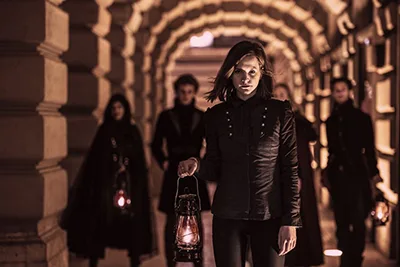
Experience a delightful 2-hour historical evening stroll at Buda Castle. Allow our charming Gothic-inspired guide to regale you with captivating tales of medieval Budapest, including epic battles, intriguing vampire lore, and enchanting Hungarian folk stories.
Szentháromság tér (Holy Trinity Square) and its Surroundings
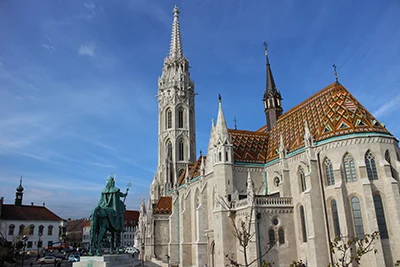
The centre of Budapest Castle District is at Szentháromság tér (Holy Trinity Square).
The Holy Trinity Statue, the Old Town Hall, and Matthias Church are here.
Matthias Church (Mátyás templom)
Location: Szentháromság tér, Buda Castle
Open: Mon – Fri: 09.00 – 17.00, Sat: 09.00 – 13.00, Sun 13.00 – 17.00
Admission:
- Adult: 1 400 HUF
- Children up to 6: free
- Students, retirees: 1 000 HUF
- Family ticket: (1-2 adults +children): 3 300 HUF
- Audio guide + 500 HUF
Ticket is valid to the church and to the museum.
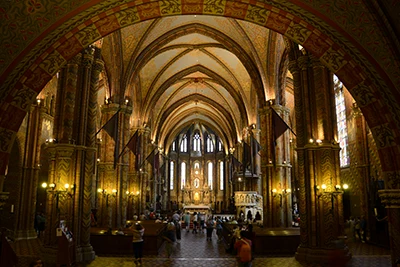
According to a legend, our first king St. Stephen started to build the church, but it hasn’t been proved yet.
Historical proof shows that King Béla IV founded the church in 1255 after he moved his court up to Castle Hill from Óbuda.
However, its name comes from the fact that the popular King Matthias held both of his weddings here.
You can view Matthias’ small collection of religious treasures in the church museum.
The interior is very striking. Despite the vaulting and the stained glass windows, it’s nothing like a Gothic cathedral; it has a sort of mystic, Eastern atmosphere.
The wall paintings are scenes from the Bible and events from Hungary’s history. The church has excellent acoustics, so it often houses concerts. Matthias Church is probably the most popular place to get married in Budapest.
The Church’s Bell Tower
The bell tower also functions as a lookout tower. You can climb up to its lower terrace at 47 m on 197 steps and enjoy the splendid view.
The tower’s renovation was finished in 2015 and the lookout tower opened to the public in October 2015. Visiting hours: 10.00-17.00 every day, at every hour (max. 15 people can go up at once).
Admission: full price: 1 400 HUF, students/retirees: 1 000 HUF, free for children under 6 years of age.
There are two hotels near Szentháromság tér:
- a luxury hotel: Hilton Budapest Hotel (Hess András tér 1-3.) and
- a small but cosy budget hotel: Burg Hotel (Szentháromság tér 7-8.).
Fishermen’s Bastion
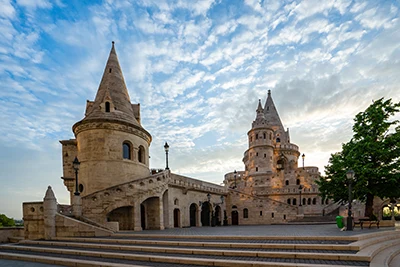
Open: lower level: 24 hours daily, upper-level lookout: 16. March – 30. April: 9.00-19.00, 01. May-15. October: 9.00-20.00
Admission to the upper-level lookout terrace:
- adult: 800 HUF, 10 % discount with Bp. Card,
- students between 6-14, pensioner from EU countries: 400 HUF
- free for children under 6 years.
Entry is free between 20.00-9.00, and between 16. October – 15. March. It is also free also free on public holidays.
As part of the renovations of the castle, the neo-Roman Fishermen’s Bastion was added between 1895 and 1902.
Despite the name it’s not part of a fortress and not even from the middle ages.
The bastion is a look-out terrace. It has seven turrets, one for each of the Hungarian tribes.
There are two explanations about the origin of the Bastion’s name: some say a fish market was nearby in the Middle Ages, according to others, the Guild of Fishermen defended this part of the wall.
The design – work of Frigyes Schulek – was inspired by the Far East. “Kitchs but beautiful” according to the writer Szerb Antal. From its top you get one of the city’s best panoramic views.
Restaurant with View
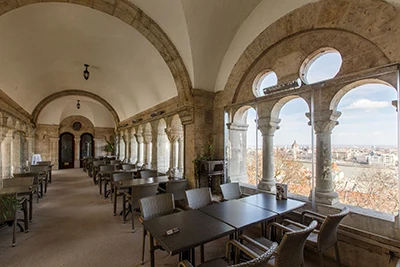
TIP: to enjoy the breathtaking view and a fine meal try the Halászbástya Restaurant.
You can eat inside the Knight Hall or enjoy the panorama from one of the terraces (Margaréta Terrace, Halászbástya Terrace) (entrance is to the right of the Fishermen’s Bastion).
The restaurant is open all the year round from 10.00 – 22.00.
The Halászbástya Terrace of the restaurant is open from spring till autumn from 10.00 to 22.00.
Prices are on the high side (soups: 1 400 – 2 200 HUF, main courses: 2 600-9 000 HUF).
View From Fishermen’s Bastion

The terraces of the bastion offer one of the best panoramic spots of Budapest.
Labyrinth in Buda Castle – Budavári Labirintus
- Entrance 1: Úri utca 9., two minutes walk from Szentháromság tér, GPS: 47.50018° N, 019.03408° E
- Entrance 2: Lovas út 4/A. – GPS: 47.499637° N, 19.033177° E (accessible with wheel chair) Opening hours: 10.00-19.00 every day[
To make the area even more romantic, beneath Budapest’s Castle Hill stretches a labyrinth of caves, tunnels and cellars.
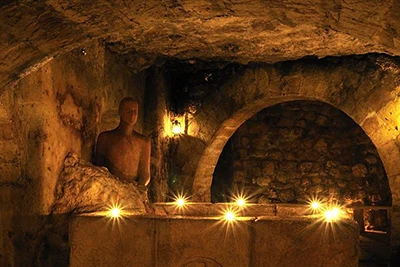
It’s about 10 km in length and a section of about 1.5 km is open to visitors.
Part of the labyrinth was formed naturally; the other parts were excavated mostly in the Middle Ages for protection purposes.
During World War II thousands lived through the siege down there.
Exhibitions
- Medieval architecture – travel back in time under the ground to see the magnificent royal palace of King Sigismund of Luxembourg and King Matthias as well as monuments from the era of the Turkish rule.
- Dracula’s Chamber – The infamous count was imprisoned here by King Matthias for 12 eyars in the 25. century.
- Opera Panoptikum – The Masked Ball of the Black Count: a wax exhibition retelling a tale of another legendary figure, the Black Count.
- The Most Beautiful Caves of the World – a photo exhibition
- Nightime Tours with Lantern: start at 18.00.
Tickets:
- adult: 2 500 HUF,
- students/pensioners/teachers: 2 000 HUF
- children up to 12 years of age: 600 HUF,
- guided tours (by appointment): 5 500 HUF
- admission is free for people with disabilities
TIP: The temperature in the Labyrinth is around 14 – 15 Celsius and humidity is 90% so bring a coat or sweater with you!